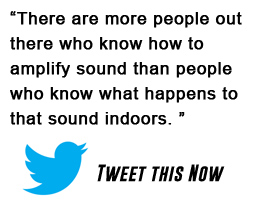Sound and acoustics go together like peanut butter and jelly. Unfortunately there are more people out there who know how to amplify sound than there are people who know what happens to that sound in a confined space. Here are ten things to consider when dealing with acoustics:
10 Things Every Sound Tech Should Know About Acoustics – How to Balance the Sound in Your Church
1. Direct Sound vs. Indirect Sound – Direct sound is the sound that comes directly out of the speakers, indirect sound is sound that comes out of the speakers, bounces around the room a little, then gets to your ears. The goal of a good sound system is not just to be loud, but to have more direct sound than indirect sound.
2. Dispersion Angle – Every speaker has a vertical and horizontal dispersion angle. By focusing the sound coming out of the speaker onto the seats, you’ll ensure more direct sound. Many times sound energy is wasted by improper speaker placement, which causes much of the sound from your speaker to push more indirect sound into your room.
3. Phase –  Sound can behave strangely sometimes. When you play the exact same thing through two speakers, at the same time, and point both speakers at each other some frequencies can completely drop out and become inaudible and others double in volume. This phenomenon is known as phase. Many time when micing the top of the snare drum and the bottom, its a good idea to hit the phase reversal switch on the board to bring the bottom mic into phase with the top.
Sound can behave strangely sometimes. When you play the exact same thing through two speakers, at the same time, and point both speakers at each other some frequencies can completely drop out and become inaudible and others double in volume. This phenomenon is known as phase. Many time when micing the top of the snare drum and the bottom, its a good idea to hit the phase reversal switch on the board to bring the bottom mic into phase with the top.
4. Parallel Walls – Whether ceiling to floor, or right to left, parallel walls can be a nightmare. In the example above I said if you point two speakers at each other some frequencies can come in our out of phase. Parallel walls have the exact same effect. Often times sound gets “stuck” between parallel walls and cause a great deal of unwanted indirect sound. When in a room with parallel walls, do everything you can to keep sound off the walls.
5. Corners – Corners have a tendency increase low frequencies. If your speakers are near a corner, consider moving them.
6. Absorbers – Acoustic absorbers are a great way to control the amount of indirect sound in a room. The best acoustic absorber is a human. People are about 75% water, and sound has a hard time going through us. There are times that even with enough people, supplemented acoustic control is necessary (though much of it can be avoided by proper installation).
7. Panning – There is a controversial concept out there that panning sound to the hard left and right will “create space” in a mix. This effect works great in recorded sound, but not so great in a live environment. Panning just means that half the audience doesn’t hear what the other half is hearing.
8. Stage Noise – The acoustic battle will forever rage in churches as long as beautiful buildings are built without consideration as to how they will sound. Many times we make an altar conform to the needs of a sound stage when we should have built a sound stage that can function as an altar. If you happen to be stuck in that battle, do everything you can to keep stage noise down: cage your drums, swap wedges for in-ears, trade amps for going direct. In the long run it really will sound better without your Marshall half stack cranked to 11.
9. Subs – Subs should never be flown in the air. Low end by nature has larger waveforms which are controlled more efficiently when the subs are coupled to the floor. You will need almost twice as many subs to fly in the air as you would if they were on the ground. Stadiums and other extremely large venues of over 4,000 people are the only exception.
10. Feedback – Feedback is the result of a loop gaining in volume. When a microphone that is usually turned up too loud starts to pick up the sound of the monitor or speaker near it, the mic amplifies the sound from the speaker. Once the loop begins, usually as a single frequency, it aligns itself into phase and gets louder and louder and louder until someone moves the mic or hits the mute button. One of the best ways to reduce feedback is to make sure your mics aren’t pointed at speakers.
What are some acoustic tips I might have missed?

